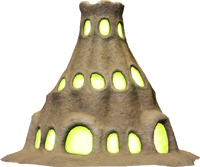Lumiknoll
| |||
|---|---|---|---|

| |||
| Appears in | Pikmin 4 | ||
| Scientific name | Collux aeternium | ||
| Family | Unknown | ||
| Areas | Sun-Speckled Terrace, Blossoming Arcadia, Serene Shores, Hero's Hideaway, Giant's Hearth, Primordial Thicket | ||
| Caves | None | ||
| Dandori Challenge levels | None | ||
| Dandori Battle levels | None | ||
|
This article is a stub. You can help Pikipedia by expanding it. |
Lumiknolls (ヒカリヅカ?, lit.: "Light Anthill") are large dirt mound nests found in night expeditions in Pikmin 4. They are the home to Glow Pikmin, and function similarly to the Onion, although their behavior is quite different.
Lumiknolls produce Glow Pikmin when fed with glow pellets; for every three pellets they are fed with, they will produce one Glow Pikmin. Unlike Onions, when Glow Pikmin are produced, they will automatically appear at the player character's location. Juvenile Lumiknolls, known as Tricknolls, are also found within night expeditions and serve as an extension of the Lumiknoll. All pellets transported to Tricknolls are then transferred to the main Lumiknoll and propagate Glow Pikmin.
During a night expedition, creatures will be attracted to the Lumiknoll and will try to destroy it; the player must subsequently either defeat all the attacking creatures or ensure that the Lumiknoll survives until the dawn. If Tricknolls have been activated, the enemies will attack them first, which can buy time for the player to prepare better defenses. Occasionally, two Lumiknolls are present in an area at once- while they have separate health meters, the destruction of either Lumiknoll will cause the expedition to fail, so the player must work with Oatchi to ensure that both of them are kept safe.
When successfully protected, Lumiknolls produce an extract known as glow sap, which is used to cure castaways from their leafling affliction.
Notes[edit]
Dalmo's Notes[edit]
“Nature is a high-risk, high-reward type of environment. The Lumiknoll braves the danger, risking self-destruction to emit a light that lures creatures so it can propagate more Glow Pikmin using glow pellets! But is that all? Could the glow sap also be luring us?”
Olimar's Notes[edit]
“Besides the fact that they serve as incubators and nests for Glow Pikmin, we know very little about the Lumiknoll's ecology. When nocturnal creatures die, a Lumiknoll can break them down into glow pellets through its strong dissolving enzymes. This matter, when condensed, becomes glow sap. One might assume glow sap is then an extremely dangerous substance, but it has hardly any negative effects. In fact, I've had it administered to me personally as a curative medicine to break down growing leaves. Lumiknolls will only appear in places where an Onion was located earlier in the day, and since they propagate Glow Pikmin, one could surmise that they are rhizomes from those Onions. Perhaps, using its dissolving powers, it returns the nectar that supports the ecosystem back to the soil.”
Louie's Notes[edit]
“Smells a lot like an Onion. The green juice is particularly delicious!”
Pikmin Garden[edit]
Text
“ヒカリピクミンの巣や母体となる塚のようなもの。昼にオニヨンがあった場所の近くに、夜になると現れ、淡い緑色の光で夜行性の生物を引き寄せる。
特徴 その1 ヒカリピクミンの巣
- ヒカリピクミンの巣であり、母体でもある。ヒカリペレットを栄養にして、ヒカリピクミンを生み出す。
特徴 その2 オトリヅカ
- ヒカリヅカの幼体。小さいながらも、夜行性の生物をおびき寄せる。
- (Image text: ヒカリヅカとは地下でつながっていて栄養を取り込める)
特徴 その3 ヒカリのミツ
- 高い分解酵素を含んだエキスを明け方になると吐き出す。”
Translation
“A mound-like object that serves as a nest and incubator for Glow Pikmin. It appears at night near where an Onion was during the day and attracts nocturnal creatures with its pale green light.
Feature #1: Glow Pikmin nest
- It is a nest and incubator for Glow Pikmin. It spawns Glow Pikmin using glow pellets as nourishment.
Feature #2: Tricknoll
- A juvenile Lumiknoll. Although small, it attracts nocturnal creatures.
- (Image text: "It is connected underground to a Lumiknoll and can take in nutrients")
Feature #3: Glow sap
- At dawn, it spits out an extract containing strong dissolving enzymes.”
Naming[edit]
- Common name: Lumiknoll. It is a pun of "lumino-", Latin for small lights, and "knoll", a small hill. The name could also be a pun on the chemical Luminol, used to detect trace amounts of blood in crime scenes. Like a Lumiknoll, Luminol emits a luminescent glow, although this glow is blue unlike a Lumiknoll's green.
- Japanese nickname: ヒカリヅカ?, lit.: "Light Anthill". This refers to how it emits light and how it looks like an anthill.
- Japanese name: トコヨノヒカリヅカ?, lit.: "Light Anthill of the Underworld".
- Scientific name: Collux aeternium. Col- means "with" in Latin when joined with another word. Lux means "light" in Latin, hence Collux means "with light" while aeternum means "eternal" or "everlasting." Altogether, it could mean "with light everlasting."
- Internal names:
WASURENAGUSA. It is a romanization of ワスレナグサ? (lit.: "forget-me-not"). - Prerelease: None.
Names in other languages[edit]
Lumiknoll
| Language | Name | Meaning | Notes |
|---|---|---|---|
| ヒカリヅカ? Hikarizuka |
Light Anthill | From ヒカリ? (lit.: "light") and アリ塚? (lit.: "anthill") | |
(traditional) |
發光巢穴 Fāguāng Cháoxué |
Glow Nest | |
(simplified) |
发光巢穴 Fāguāng Cháoxué |
Glow Nest | |
| Gloeikolonie | Glow colony | ||
| Lumilière | Glowing anthill | From "lumineux" (glowing) and "fourmilière" (anthill) | |
| Leuchtbau | Glow Burrow | ||
| Luminotana | Glowing den | From "luminosa" (glowing) and "tana" (den) | |
| 빛둑 Bitduk |
Lighthill | From 빛 (light) and 개밋둑 (anthill) | |
| Lampireiro | Firefly anthill | From "pirilampo" (firefly) and "formigueiro" (anthill) | |
| Lumiloma | Glowing hill | From "luminosa" (glowing) and "loma" (hill) |
Tricknoll
| Language | Name | Meaning | Notes |
|---|---|---|---|
| オトリヅカ? Otorizuka |
Decoy Anthill | From おとり? (lit.: "decoy") and アリ塚? (lit.: "anthill") | |
| Leuchtköder | Glow bait |
Glow pellet
| Language | Name | Meaning |
|---|---|---|
| ヒカリペレット? Hikari Peretto |
Light Pellet | |
| Leuchtknopf | Glow button |